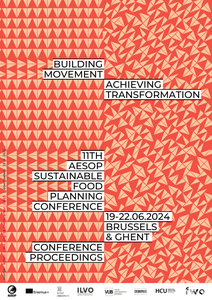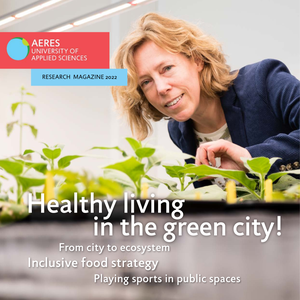Citizens living in food poverty can easily get caught up in a vicious cycle. Socio-economically disadvantaged people often rely on food assistance and are more likely to suffer from diseases caused by unhealthy diets, such as diabetes. They may also experience isolation and lack social networks, as they do not have the financial means to participate in social life. Moreover, this group is often overlooked in decision-making processes regarding healthy and sustainable food environments. To create equitable food environments in urban areas, it is crucial to incorporate the everyday challenges and needs of socioeconomically disadvantaged people. In our collaborative research, we explore the needs of socioeconomically disadvantaged people regarding a healthy and sustainable diet in Switzerland and the Netherlands. The aim is also to develop, in a participatory way, ideas on how to create more socially just and inclusive food environments.Keywords: food poverty, food environments, social participation, participatory action research
DOCUMENT

The design and realization of a healthy indoor environment is a challenge that is investigated from different perspectives at the unit Building Physics and Systems (BPS; Faculty of Architecture, Building and Planning) of Eindhoven University of Technology. Performance requirements (for instance, with respect to air quality, thermal comfort and lighting) and performance based assessment methods are the point-of-departure, focusing at computational techniques supporting the design process. Different specific application fields such as dwellings, offices, schools, but also, operating theatres, churches, musea and multifunctional stadiums, underline the applied approach that is part of the research within the unit. In the design of healthy environments, the performance based design assessment is crucial in arriving at innovative design solutions and optimized indoor and outdoor environments. In this assessment computational support tools and experimental verification play an important role. However, assessing the right indicators in an objective way, applying the correct tools and correct application of these tools is not yet well established. Alongside, developments are still ongoing. The work performed in the unit by the different researchers relates to the research questions that can be derived from this notice. The paper gives an introduction to the Unit BPS and presents a brief overview of recent and ongoing research. An extensive list of references is provided for further reading and supports the conclusion that healthy environments can and should be addressed from a wide angle.
LINK
The ageing population demands designing environments while considering their functional needs, desires and wishes. The ICF framework together with the gerontechnological principles can help to have focus on how to adjust or to (re)design the environment for this population. This paper focuses on building-related environmental factors including eHealth solutions. Knowledge and understanding of how the environment is perceived by older people help to set the building performance requirements and gives direction to improve our research to create healthy environments for future users.
LINK
As societies age, the development of resources and strategies that foster healthy ageing from the beginning of life become increasingly important. Social and healthcare professionals are key agents in this process; therefore, their training needs to be in agreement with societal needs. We performed a scoping review on professional competences for social and health workers to adequately promote healthy ageing throughout life, using the framework described by Arksey and O’Malley and the Joanna Briggs Institute Guidelines. A stakeholder consultation was held in each of the participating countries, in which 79 experts took part. Results show that current literature has been excessively focused on the older age and that more attention on how to work with younger population groups is needed. Likewise, not all disciplines have equally reflected on their role before this challenge and interprofessional approaches, despite showing promise, have not been sufficiently described. Based on our results, health and social professionals working to promote healthy ageing across the lifespan will need sound competences regarding person-centred communication, professional communication, technology applications, physiological and pathophysiological aspects of ageing, social and environmental aspects, cultural diversity, programs and policies, ethics, general and basic skills, context and self-management-related skills, health promotion and disease prevention skills, educational and research skills, leadership skills, technological skills and clinical reasoning. Further research should contribute to establishing which competences are more relevant to each discipline and at what level they should be taught, as well as how they can be best implemented to effectively transform health and social care systems.
DOCUMENT

Healthy gestational weight gain (GWG) is associated with better pregnancy outcomes and with improved health in the later lives of women and babies. In this thesis the author describes the process of developing an intervention to help pregnant women reach a healthy GWG. The need for this intervention was derived from discussions with midwives, working in primary care in the Netherlands. In this introduction, the author describes the background of the larger project “Promoting Health Pregnancy”, of which this study is a part (1.2), the problem of unhealthy GWG (1.3-1.6) and offers a brief introduction to the theoretical framework of the study and to the subsequent chapters (1.7-1.9).
DOCUMENT

With the beautiful new building of Aeres University of Applied Sciences Almere in the Floriade park, we have materialized our wish to lead the way in the green transition and its challenges. We want to be green changemakers and have the ambition to take on the challenges that we are faced with in agriculture, food and healthy living environments. We bring this about with our study programmes and increasingly with our Practice-Based Research Team. In 10 years’ time, this team has grown from our first professorship into a mature team of 20 people, of whom 7 are research professors.In this edition, three of our new professors will be introduced to you.
DOCUMENT

Objective: Gaining too much or too little weight in pregnancy (according to Institute of Medicine (IOM) guidelines) negatively affects both mother and child, but many women find it difficult to manage their gestational weight gain (GWG). Here we describe the use of the intervention mapping protocol to design ‘Come On!’, an intervention to promote adequate GWG among healthy pregnant women. Design: We used the six steps of intervention mapping: (i) needs assessment; (ii) formulation of change objectives; (iii) selection of theory-based methods and practical strategies; (iv) development of the intervention programme; (v) development of an adoption and implementation plan; and (vi) development of an evaluation plan. A consortium of users and related professionals guided the process of development. Results: As a result of the needs assessment, two goals for the intervention were formulated: (i) helping healthy pregnant women to stay within the IOM guidelines for GWG; and (ii) getting midwives to adequately support the efforts of healthy pregnant women to gain weight within the IOM guidelines. To reach these goals, change objectives and determinants influencing the change objectives were formulated. Theories used were the Transtheoretical Model, Social Cognitive Theory and the Elaboration Likelihood Model. Practical strategies to use the theories were the foundation for the development of ‘Come On!’, a comprehensive programme that included a tailored Internet programme for pregnant women, training for midwives, an information card for midwives, and a scheduled discussion between the midwife and the pregnant woman during pregnancy. The programme was pre-tested and evaluated in an effect study.
MULTIFILE

Purpose – Self-efficacy has often been found to play a significant role in healthy dietary behaviours. However, self-efficacy interventions most often consist of intensive interventions. The authors aim to provide more insight into the effect of brief self-efficacy interventions on healthy dietary behaviours. Design/methodology/approach – In the present article, two randomized controlled trials are described. In study 1, a brief self-efficacy intervention with multiple self-efficacy techniques integrated on a flyer is tested, and in study 2, an online brief self-efficacy intervention with a single self-efficacy technique is tested. Findings – The results show that a brief self-efficacy intervention can directly increase vegetable intake and indirectly improve compliance to a diet plan to eat healthier. Originality/value – These findings suggest that self-efficacy interventions do not always have to be intensive to change dietary behaviours and that brief self-efficacy interventions can also lead to more healthy dietary behaviours.
DOCUMENT

Europeans are living longer than ever in history, because of the economic growth and advances in hygiene and health care. Today, average life expectancy is over 80, and by 2020 around 25% of the population will be over 65. The increasing group of older people poses great challenges in terms of creating suitable living environments and appropriate housing facilities. The physical indoor environment plays an important role in creating fitting, comfortable and healthy domestic spaces. Our senses are the primary interface with the built environment. With biological ageing, a number of sensory changes occur as a result of the intrinsic ageing process in sensory organs and their association with the nervous system. These changes can in turn change the way we perceive the environment around us. It is important to understand these changes when designing for older occupants, for instance, care homes, hospitals and private homes, as well as office spaces given the developments in the domain of staying active at work until older age.
MULTIFILE

For the needs analysis, an assessment of the national (and local) status quo in the area of Healthy Ageing, specifically towards Active and Healthy Lifestyles. This status quo will serve as important starting point for the exploration of a potential shared goal of the local community of practice. This needs analysis report includes generic sections towards definitions and methodologies, and an introduction towards the topics assessed. Secondly, national/ local chapters will outline the situation in the communities of Groningen (the Netherlands), Odense (Denmark), Malaga (Spain), Kaunas (Lithuania) and Cascais (Portugal). Within each local COP chapter the partners taking part of the COP are described and the shared goals illustrated. These shared goals are: COP Groningen: “stimulating a Healthy environment (physical & social) with focus on physical activity”. COP Odense: “further develop and educate professionals who work on stimulating physical activity in community dwelling older adult”’. COP Malaga: “developing, implementing and evaluating outdoor fitness” COP Kaunas: “to provide opportunities for primary school children and Kaunas district community members older than 50 more opportunities for exercising and physical activity” COP Cascais: “develop, organize for and together with the stakeholders and end users (youngsters from 12-24 years old) activities focused on healthy lifestyle (e.g., healthy cooking workshops, parent-child physical activities etc.) embedded in approach GERAÇÃO S+ “.
DOCUMENT
